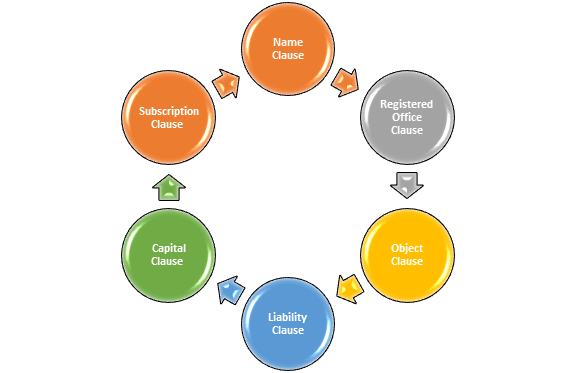What is a memorandum of association?
The firm's charter is represented by the memorandum of association (MOA). It's a legal document written during the registration and formation of a limited liability firm to outline the corporation's relationship with its shareholders.
Moreover, limited liability is a legal framework for a company where a business loss is limited to the sum invested in a limited liability company (LLC) or partnership. To put it another way, if the corporation fails, the owners' and investors' assets are not at risk.
In addition, the firm's constitution is comprised of the Articles of Association and the memorandum of association. However, the MoA sets the barrier beyond which the corporation's actions are not allowed, and the firm is only permitted to engage in those activities stated in the MoA.
The memorandum of agreement makes it easy for shareholders and anybody else who engages with the firm to grasp its core rights and authority. In addition, the MoA's content assists potential shareholders in making the best judgement possible when considering an investment in the firm.
However, the names of shareholders, the name of the firm, the distribution of shares, and the physical address of the registered office are all available to the public. Because the memorandum is a public document, if an individual wish to enter into any agreements with the firm, they must pay the necessary fees to the Registrar of Companies and acquire the MOA.
In addition, two subscribers should sign the MoA if it is a private limited firm, and seven members should sign if it is a public limited corporation.
Although the MOA is never used in the United States, it is a legal obligation for limited liability firms in European nations such as the Netherlands, France, the United Kingdom, and some Commonwealth nations.
Summary
- The firm's charter is represented by the memorandum of association (MOA).
- The memorandum acts as the firm's overall structure's foundation and outlines the firm's operational limitations.
- The MOA establishes a line beyond which the corporation's actions are prohibited, and the firm is only permitted to engage in those activities specified in the MOA.
Frequently Asked Questions (FAQs)
What role does a memorandum play in a business?
The significance of the memorandum of association is stated below.
- The memorandum serves as the foundation for the firm's whole structure.
- It puts forth a firm's written objectives.
- It explains the firm's constraints.
- It outlines the firm's scope of operations.

Source: © Neelsky | Megapixl.com
What is the memorandum of association's provisions?
Name Clause
This clause defines the firm's name, which should not be the same as any other business. However, in a private firm, the term "Private Limited" must be added to the end of its name, and if it is a public corporation, the term "Limited" must be added at the end. So, for instance, if it's a private organisation, it should be called XYZ Private Limited, and if it's a public corporation, it should be called XYZ Ltd.
Furthermore, a firm has complete control over the name it chooses. It must not include words such as Emperor, King, Government Bodies, Queen, or names of international organisations such as the World Bank, World Health Organisation, United Nations Organisation, etc.
Registered Office Clause
This clause must include the name of the state where the firm's registered office is situated. This will aid in determining the Registrar of Corporations' jurisdiction. The term "registered office" refers to the site where the firm's statutory books, common seal, and other documents are held. Within 30 days of the firm's formation or beginning, the firm must notify the Registrar of Companies of the location of its registered office.
A firm's registered office can be moved from one site in town to another with a simple notification to the Registrar. However, the situation may arise if the firm does not desire to relocate its registered office to another location within the state. So, under the circumstances, the only option is to adopt a special resolution. Moving the registered office to a new state, on the other hand, necessitates a change to the memorandum.
Object Clause
This clause explains why the firm was founded and included an overview of the firm's operations. The object clause must specify the firm's purpose and indulgence in operations. Any such operation that is not specified in the object clause is regarded to be beyond the firm's grasp. The following three subcategories can be found in the objectives:
- Main Goal: It explains the firm's primary business.
- Incidental Objectives: These are the goals that aren't directly related to the firm's principal goals.
- Other objectives: Any other goals that the firm may pursue that aren't mentioned in (a) and (b) above (b).

Source: Kalkine Media
Liability Clause
It outlines the firm's members' liability. If the firm is unlimited, the members' liability is infinite; but, if shares limit the firm, the members' liability is limited to the amount owed on their share. In the case of a firm limited by guarantee, however, the members' liability is limited by the amount each member has pledged to give.
Capital Clause
This clause explains the highest sum of money that the firm can raise and the division of capital into stocks. The company will not guarantee more capital than that specified in this clause. If certain stockholders are given privileges or rights, they may be mentioned in this provision.
Subscription Clause
It includes the names and addresses of the initial subscribers. The memorandum's subscribers should take at minimum one share. In a private firm, the minimum number of members should be two, whereas, in a public firm, the minimum number should be seven. As a result, the memorandum of association is the firm's cornerstone and most important paper.
 Please wait processing your request...
Please wait processing your request...